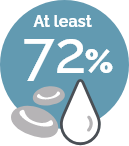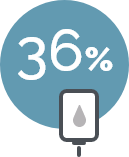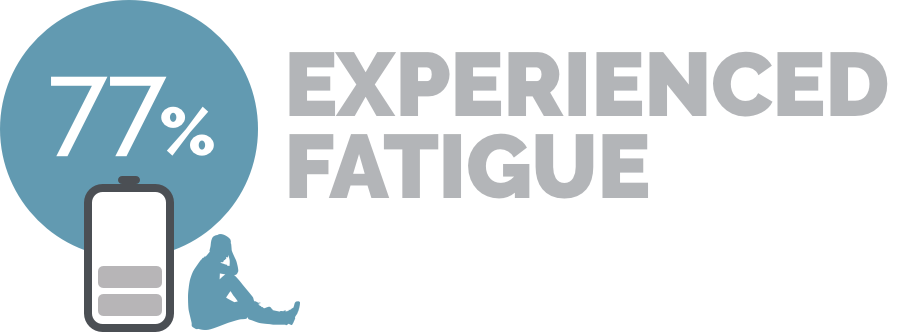HEMOLYSIS REMAINS ONGOING IN MANY TREATED PATIENTS WITH PNH1-4
C5 inhibition has improved patient survival by addressing IVH, yet many patients with PNH continue to experience symptoms of ongoing hemolysis and persistently low Hb1,2,5,6
treated with C5 inhibitors7,8*†:

ONGOING HEMOLYSIS, SHOW A STRONG
CORRELATION TO QoL PARAMETERS (r=0.76).9

TRANSFUSION

*A retrospective analysis of eculizumab-treated patients with PNH treated in the Leeds Center of the UK PNH National Service was conducted to determine if laboratory
parameters apart from LDH are stronger indicators of EVH. The poster was presented at the 2017 ASH Annual Meeting (McKinley et al) and the abstract published in Blood 2017.8
†A cross-sectional survey was administered to adult patients ≥18 years of age being treated with either eculizumab or ravulizumab in the US with a self-reported diagnosis of PNH. Patients were recruited through a patient advocacy group in July 2020. The survey is ongoing and the results are preliminary. This abstract was presented at the 2020 ASH Annual Meeting (Dingli et al) and published in Blood 2020.7

†A cross-sectional survey was administered to adult patients ≥18 years of age being treated with either eculizumab or ravulizumab in the US with a self-reported diagnosis of PNH. Patients were recruited through a patient advocacy group in July 2020. The survey is ongoing and the results are preliminary. This abstract was presented at the 2020 ASH Annual Meeting (Dingli et al) and published in Blood 2020.7
Your patients with PNH may be struggling with these symptoms of ongoing hemolysis1,2,5
*A retrospective analysis of eculizumab-treated patients with PNH treated in the Leeds Center of the UK PNH National Service was conducted to determine if laboratory parameters apart from LDH are stronger indicators of EVH. The poster was presented at the 2017 ASH Annual Meeting (McKinley et al) and the abstract published in Blood 2017.8
†A cross-sectional survey was administered to adult patients ≥18 years of age being treated with either eculizumab or ravulizumab in the US with a self-reported diagnosis of PNH. Patients were recruited through a patient advocacy group in July 2020. The survey is ongoing and the results are preliminary. This abstract was presented at the 2020 ASH Annual Meeting (Dingli et al) and published in Blood 2020.7
EVH=extravascular hemolysis; Hb=hemoglobin; LDH=lactate dehydrogenase; PNH=paroxysmal nocturnal hemoglobinuria; QoL=quality of life; RBC=red blood cell.
References: 1. Hill A, et al. Nat Rev Dis Primers. 2017;3:17028. 2. Risitano AM, et al. Blood. 2009;113(17):4094-4100 3. Risitano AM, et al. Front Immunol. 2019;10:1157 4. Debureaux PE, et al. Abstract presented at: 61st American Society of Hematology Annual Meeting; December 7-10, 2019: San Diego, Ca. 5. Lee JW, et al. Am J Hematol. 2019;94(1):S1-S2. 6. Loschi M, et al. Am J Hematol. 2016;91(4):366-370. 7. Dingli D, et al. Blood. 2020;136(suppl 1):2. 8. McKinley CE, et al. Blood. 2017;130(suppl 1):3471. 9. Ueda Y, et al. Int J Hematol. 2018;107(6):656-665.


